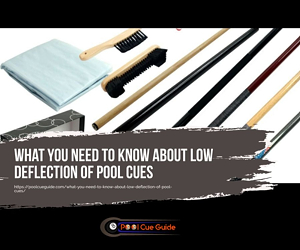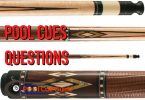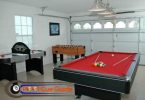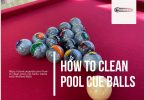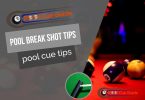Shafts with slight deflection are relatively innovative. Consequently, numerous pool current players figured out how to play with conventional shaft cues, whereas others started learning how to perform with low deflection (LD) shaft cues. Conventional shaft users stick by their cues, whereas LD users vouch for theirs. It isn’t easy to know who to trust, particularly when you’re familiar with the game. As a result, it’s pretty unusual to encounter, “Will I need a low deflection pool cue?”
If you require a low deflection pool cue, it all depends on the requirement like a professional, your degree of expertise, as well as how serious you are about improving. In principle, anybody seeking to enhance their pool abilities can invest in a low deflection cue. The acquisition of a low deflection pool cue might not be advantageous to amateur gamers or those who have competed with typical shafts for a great many years.
You’re not the only one if you’re considering purchasing a pool cue with a low deflection. The more people who start playing pool, the more these queries arise. We’ll tell you all that you need to understand (and more!) regarding low deflection pool cues in this article. So, stay with us until the end to figure out whether or not you should invest in a low deflection cue?
Content Navigation
- 1 What is a Low Deflection Pool Cue?
- 2 Low Deflection Cue History
- 3 So What Exactly Makes a Low Deflection Pool Cue Work?
- 4 And, Who Introduced the Deflection Technology?
- 5 Advantages and Drawbacks of Low Deflection Cue Pools
- 6 So, What’s the Cost Difference?
- 7 Should I Invest in a Low Deflection Cue Shaft or Not?
- 8 Our Recommendation for the Best Pool Cue Shaft
What is a Low Deflection Pool Cue?
Pool cues with low deflection are meant to decrease “squirt” as often as feasible. The cue ball’s angled shaft often referred to as deflection or squirt, comes to no surprise whenever you strike the cue ball. Each stroke you make has a certain amount of squirt; however, LD shafts minimize it as much as necessary to maximize precision.
In theory, the more the sidespin or the “English” you put on the cue ball, as they say, the more squirt you’ll get. A straighter stroke, such as a breaking shot, will have a petite squirt, but a strike with a load of English will have much more squirt and thus more departure from the desired outcome.
Because there is more squirt while using regular shaft cue sticks, you learn to adjust. There will be more petite squirt on low deflection cues, and so as a consequence, lesser correction is necessary. That’s why it’s difficult for some players to move between the two approaches; they eventually wind up paying too much or too little.
Low Deflection Cue History
Predator is the brand of the firm that is known for creating this technique. They were known as Clawson Cues after the company initially released the low deflection (LD) shaft in the late 1990s. Meucci was the first manufacturer to offer the LD shaft, while Predator had a solid promotional approach.
Whichever the scenario could be, Predator is now widely regarded as the leading manufacturer of high-quality low-deflection billiard cues. At least either of these Predator cues appears almost on each “Top Low Deflection Cue” ranking:
- Predator Z-Shafts 3rd Generation
- Predator Revo
OB Cues, on the other hand, appears to be attempting to compete with Predator. Considering excellent low deflection cues, individuals seem to prefer the OB2 and OB1, mainly.
So What Exactly Makes a Low Deflection Pool Cue Work?
In easier words, the suppler the tip of the shaft is, the less displacement (squirt) it will cause. Conventional shafts are often composed of a single compact bit of timber, making the tips less elastic and causing increased deviation.
The key is to create a cue shaft that is as diverse as practical while being robust, well-built, and long-lasting. Cue makers accomplish this in a few various manners.
A hollowed tip around 6″ in size coupled with cushioning in the ferrule to soften contact is by far the most popular model for low deviation shafts. To minimize mass while retaining durability, some producers empty the shaft end then load it with lightweight hardwood, carbon fiber, and foam.
To minimize deflection even more, specific low deflection cues feature somewhat shorter ferrules and tips. This all helps to decrease the shaft’s tip weight, allowing the tip to move out of the way of the cue ball shortly following a collision. The shaft on traditional cues forces the ball out from the path, producing additional deviation.
The power produced by the collision between the ball and the cue should go someplace. With LD shafts, the cue tip absorbs some of the energy, while on regular shafts, the cue ball absorbs it.
Rubber is frequently utilized because it preserves and keeps the new shaft’s mobility. However, alternative materials, such as carbon fiber or balsa wood, are significantly lighter than the substance utilized for the remainder of the shaft, which is most likely maple.
And, Who Introduced the Deflection Technology?
Though several manufacturers today provide their versions of the low deflection cues, Predator was the first to develop the concept. That was performed in the late 1990s while they operated by another identity, although Meucci also published a cue at about the same time.
Both of those businesses continue to produce excellent cue sticks with low deflection nowadays, but many other outstanding producers are also there. Purex, Lucasi, McDermott, Predator, and OB have all ensured that the marketplace for the finest low deflection shafts is fiercely competitive.
Advantages and Drawbacks of Low Deflection Cue Pools
We’ve seen a summary, but what are the specific benefits and drawbacks? We’ll take a closer look to determine if a low deflection shaft is the correct choice for you.
Beginning with the advantages:
- Consistency – All of the additional benefits listed above combine to provide significantly greater shot reliability. This implies that even if someone strikes the cue ball twice in succession at about the same spot, it will follow the same proportional direction. Obviously, there will still be a lot of talent required, though your strokes will get more consistent as you go.
- More Room for Error – Whenever you compete with a low deflection shaft, you eliminate stroke variance caused by deviation. That implies your ball will travel wherever you would like it to travel frequently, and a minor angling mistake won’t be sending your cue ball flying too far. Low deflection shafts, in this sense, allow you a bit greater leeway than conventional cues.
- Accuracy – As previously stated, the low deflection shaft allows for much more precise strikes by requiring minor adjustments. That’s the most significant advantage of using such cues. And besides, precision might be the distinction separating victory and defeat.
- Lower Learning Curve – Low deflection cues have a shorter learning curve for individuals who are just commencing out or becoming serious regarding their play. Beginners and advanced competitors will find it much simpler to improve their abilities with LD cues because they provide much less squirt. More significant adjustment equals more deviation and implies a steeper learning curve.
- Durability – Low deflection cues usually survive longer than their regular counterparts, given the overall manufacturing excellence and the resulting premium price label. For rotational uniformity, several LD cues are further strengthened with a specific type of lamination.
There are certain drawbacks to using low deflection cues, but many of these have more to do with personal taste than the cue itself. Here are some instances of what I’m talking about.
- Trouble Switching – As previously said, following years of using a typical cue, switching to a low deviation cue might be challenging. That’s not difficult, although getting acclimated to the distinction between compensation and squirt, particularly while placing English on a ball, takes some experience.
- Feel and Sound – Low deflection cues have been criticized for their sound and feeling by certain professionals. They occasionally produce a hollowed-out tone whenever they strike the cue ball, although that’s more of an individual preference than anything else. The smoother sensation they make, particularly around the tip, will be the same. The shaft of a 19-ounce cue would still weigh 19 ounces, but it could appear lightweight to users who are used to regular shafts.
- Difficult to Jump – Because LD cues have far less bulk in their shaft tips, perfecting jump shots using these might be a little more challenging. Obviously, when you’re passionate about billiards, you could always get a dedicated jump cue.
- Quite Expensive – Low deflection cues are more expensive than conventional cues because they demand more intricate manufacturing. However, that’s not always a terrifying experience. They have excellent tips, ferrules, and patterns as well. You can acquire a high-quality cue that would last a lot longer if you do some homework beforehand purchasing. You get what you pay for, just like everything else.
So, What’s the Cost Difference?
Cues with a low deviation are typically preferred over conventional cues. It’s unusual to encounter a high-end cue that doesn’t feature a low-deflection shaft as default. Consequently, LD cues generally are considerably costly than standard cues. However, some gamers argue that the price rise is justified.
The majority of low-deflection cues also have improved wraps, butts, ferrules, and tips. Keep an eye out for cues that pretend to be LD for less than $200. These are conceivable; however, the remainder of the cue may not even be up to par.
Should I Invest in a Low Deflection Cue Shaft or Not?
You might be questioning whether or not a low deflection shaft is an intelligent choice now that you know what precisely a low deviation pool cue entails.
Individuals who are used to competing with a conventional cue might consider these challenging to get a grip on them at first; however, most professionals should quickly adapt.
Whenever many players become accustomed to it, they discover that they enjoy the increased precision and command.
Some individuals genuinely don’t like these; it’s a personal taste, but when you can handle it, we’d recommend giving it a try – or at the very minimum, borrowing one from a neighbor before purchasing one for yourself.
Using an LD cue to practice can increase your reliability and precision. This will hasten the learning experience and provide a bit more leeway for mistakes. The LD cue would also serve you a long time if you properly take care of it.
Avoiding moving back and forth between the two styles at all costs would be better in the long term. This should add to the length of time it requires to improve your abilities. Choose one which feels appropriate to you, whether that’s low or conventional deflection, and stay with it.
Our Recommendation for the Best Pool Cue Shaft
Predator has now been producing LD shafts for a great many years, as previously stated. This does not suggest that those other companies aren’t making high-quality LD shafts; however, Predator has an established track record in this department.
The Predator Z-Shafts and Predator Revo, as mentioned above, are worth checking out, but the Predator 314 is among their most preferred shafts. The 314 has already been improved several times and therefore is currently known as the 314-3. 3rd Generation). That’s, without a doubt, among the most renowned LD shafts available! If you approach any pool shark about the 314, 9 out of 10 would know precisely what you’re talking about.
Conclusion
Low deflection cues, when firstly introduced, fascinated cue enthusiasts with their amazing technological advancement that allowed for a better deviation once stroke the cue ball.
Over time, it became popular and so, we thought why not dive in a little deep to give our pool family a better understanding of what the fuss is all about!
We hope you understand what a low deflection pool cue is and the advantages it provides.
This is a question of individual preference, even though most people like LD shafts. However, some people would prefer normal shafts and alter their stroke-play to allow for squirt.
While you’re considering purchasing a low deflection cue, you’ll have to be able to balance the upsides and downsides. Because they are costly, you should only buy one if you are committed to playing pool.
You’ll enjoy the feeling and poise once you’ve done so. You’ll undoubtedly never return to playing with a standard cue after you’ve become accustomed to competing with a low deflection shaft.
Self Professed Geek , into all kinds of tech including search engine optimization , Computer networks and more. I love playing pool ( eight ball , nine ball and snooker) I own my own pool table a play daily. I love to try out new pool cues and accessories. read my review of actual pool cue i have used and use often.

